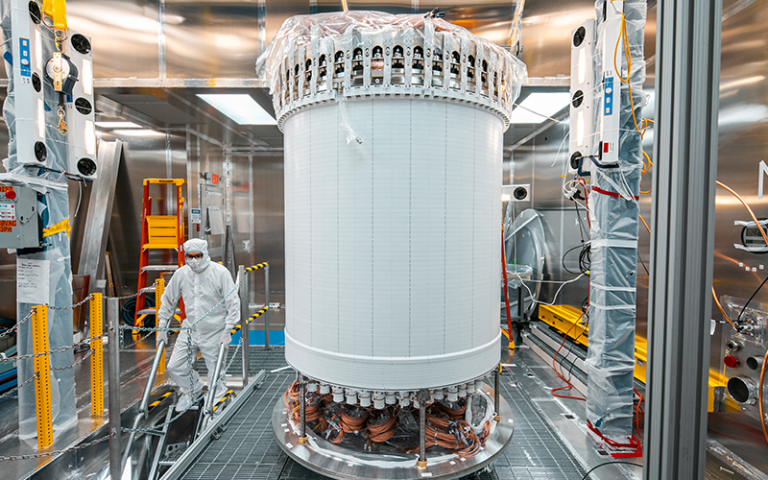World’s largest and most sensitive dark matter detector comes to life
6 July 2022
The world’s most sensitive dark matter experiment has gathered its first result, moving us a step closer to understanding one of the biggest mysteries of the Universe. It shows the experiment is successfully operating after years of set up by a team involving UCL researchers.

The international project “LUX-ZEPLIN Dark Matter Experiment (LZ)” based at the Sanford Underground Research Facility in South Dakota, US is intricately and innovatively designed to find direct evidence of dark matter – an invisible substance thought to make up most of the mass of the Universe. As it does not emit or absorb light or any other form of radiation, dark matter is particularly challenging to detect.
Professor Chamkaur Ghag (UCL Physics & Astronomy), the UCL dark matter group leader and part of LZ, said: “Uncovering the nature of dark matter is amongst the highest priorities in science. With LZ we have set a new world-limit on sensitivity and entered completely unexplored territory in the search for the missing mass of the Universe.”
The experiment now needs to run for up to 1,000 days to realise its full sensitivity. This initial result is just a fraction of that exposure, which validates the decade-long design and construction effort.
The LZ detector will try to capture the very rare and very faint interactions between dark matter and its seven-tonne liquid xenon target. To do this, LZ must be carefully and delicately calibrated and any background noise removed so the experiment can be perfectly tuned to observe these interactions.
The experiment, led by the Department of Energy’s (DOE) Lawrence Berkeley National Laboratory (Berkeley Lab), involves an international team of 250 scientists and engineers from 35 institutions from the US, UK, Portugal, and South Korea.
Funded by the Science and Technology Facilities Council (STFC), the UK team consists of more than 50 people across institutions including UCL, the universities of Bristol, Edinburgh, Imperial, Liverpool, Oxford, Royal Holloway, Sheffield and STFC’s Rutherford Appleton Laboratory.
UK lead and co-lead for the development of the LZ Xenon Detector Professor Henrique Araújo (Imperial College London) said: “An experiment of the scale and sensitivity of LZ can be unforgiving: the smallest design flaw may compromise the whole enterprise.
“And since the LZ cryostat cannot be opened underground, we needed to make sure we got it right the first time, much like if we were to launch LZ into space… Well, it looks like we did get it right.”
After the successful start, full-scale observations can begin with the hope of finding the first direct evidence of dark matter, and the team hope to collect around 20 times more data in the coming years.
UK deliverables to the experiment include an ultralow background titanium cryostat, various contributions to the central Xenon Detector, two calibration sub-systems, and one of the two international Data Centres.
A significant fraction of the very large number of radioassays – analysis to determine radiation intensity - needed to identify the best materials was led and conducted in the UK, at STFC’s Boulby Underground Laboratory and at UCL, where Professor Ghag is LZ project co-lead for delivery of radiopurity and backgrounds.
Professor Ghag added: “We assayed over 1,200 materials over many years using state-of-the-art techniques to select the purest materials to construct LZ and characterise residual noise from natural background radiation.
“This was painstaking but necessary to ensure we would be sensitive enough to go beyond any previous attempts at finding dark matter and to deliver a precise background model.
“It’s against this background model that we will evaluate any excess we find in our data that would signal the first ever robust experimental observation of dark matter.”
LZ is searching for Weakly Interacting Massive Particles (WIMPs), theorised elementary particles that interact with gravity.
WIMPs are also expected to collide with ordinary matter – albeit very rarely and very faintly – meaning very quiet and very sensitive particle detectors are needed for detection.
At the centre of the experiment is a large liquid xenon particle detector maintained at -100oC, surrounded by photo-sensors. If a WIMP interacts with a xenon atom, and produces even a tiny amount of light, the sensors will capture it.
To see these rare interactions, the detector is constructed from extremely radiologically pure must materials. But this is not enough, which is why LZ is operating around a mile underground, shielding it from cosmic rays, which bombard experiments at the surface of the earth. The detector and its cryostat sit inside a huge water tank to protect the experiment from particles and radiation coming from the laboratory walls.
Finally, the team made sure that the liquid xenon itself is as pure as possible by carefully removing a key contaminant through a complex years-long process.
Many complex systems had to come together for LZ to work, and this first result shows they are performing in harmony seamlessly.
Dr Theresa Fruth (UCL Physics & Astronomy), who led the on-site coordination to integrate the core Xenon Detector underground and commission it, said: “It has been a long road to get here with a lot of tireless work by hundreds of people over many years, but it has been worth it. Almost a century after dark matter was first postulated, we may be on the verge of discovery.”
Links
- Professor Cham Ghag's academic profile
- Dr Theresa Fruth's academic profile
- UCL Department of Physics & Astronomy
- UCL Mathematical & Physical Sciences
- Science and Technology Facilities Council
Image
- Credit: LZ Dark Matter Experiment and Sanford Underground Research Facility
Media Contact
Evie Calder
Tel: +44 20 7679 8557
E: e.calder [at] ucl.ac.uk
 Close
Close

